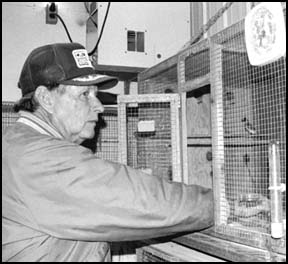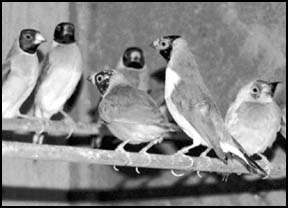Nietfeld raises birds as a sideline
This article submitted by Linda Stelling on 11/24/99.
 Ray Nietfeld's hobby of raising parakeets started out as a Christmas present from his wife, Rita.
Ray Nietfeld's hobby of raising parakeets started out as a Christmas present from his wife, Rita.
Ray (pictured at left checking the feeders in a finch cage.) received two parakeets in 1983.Ê"Every time we went to the mall, he was checking out the birds at the pet shop. I thought it would be a great gift," Rita said.
The cage they came in was too small and he made a bigger cage. While visiting the bird shop, Ray met another bird raiser. He asked him how difficult it was to raise parakeets. The man told him to add a nesting box to the cage and wait to see what would happen. This man was also quitting business and offered to sell Ray more pairs, which he did. "The parakeets started to multiply. The more I raised, the more the bird shops wanted," Ray said. He expanded into other types because the pet shops were always asking if he had finches or other colored parakeets.
Ray read bird books and magazines to learn more about raising and breeding birds.
The Nietfelds first kept the birds in the basement of the house. "They created a fine dust which filtered throughout the house," Rita said. Ray then added a room onto the barn because there were getting to be too many for the house. They moved about a dozen pair to their new quarters.
Nietfeld has also made a room on the end of his double garage for more birds. He houses about six different breeds in the garage and about 30 pair in the barn. Currently, Nietfeld has about 50 pair nesting. "I probably have more than 300 birds between the two buildings (pairs, young, and replacements)," he added.
Nietfeld said he was required to get a special permit to raise the birds on a dairy farm.
 Besides parakeets, Nietfeld raises cockatiels and Gouldian finches (pictured at right). The majority of his birds are parakeets though. His collection of parakeets consist of the grass parakeet which are a bit bigger than the regular parakeet; scarlet chested parakeets, blues, yellow, and the rosy brouchs, which are pink in color.
Besides parakeets, Nietfeld raises cockatiels and Gouldian finches (pictured at right). The majority of his birds are parakeets though. His collection of parakeets consist of the grass parakeet which are a bit bigger than the regular parakeet; scarlet chested parakeets, blues, yellow, and the rosy brouchs, which are pink in color.
"The rosy brouchs are a favorite of many people. They sell for $100 or more per bird," Nietfeld said. "The finches are popular because of their bright colors," Nietfeld added. The Gouldian Finches display bright purples, yellow, reds, and green feathers.
He stressed the green color in the parakeets is the dominate one. "The more colorful the bird, the more popular they are at the stores," Nietfeld said.
The rooms where the birds are housed needs to be kept at 70 degrees to raise young. Parakeets don't lay all their eggs at once. They lay an egg about every other day or so. "By time the last egg hatches, the first birds are ready to leave the nest," Nietfeld said.
Parakeet eggs are about the size of a jelly bean. Parakeets lay anywhere from four to six eggs per clutch, he added. "The better the feed, the better the birds grow," Nietfeld said.
According to Nietfeld, his birds live on a daily ration, consisting of white millet, canary seeds, and oat groats. They also receive a concentrate supplement made from eggs. "They are fed twice a day and the water is changed daily," he added.
Nietfeld cleans their pens after each clutch is raised to maturity. "We don't want to disturb the nest too often or the mothers won't take care of their young," he said. It takes four to five weeks for a parakeet to go from birth to maturity. "They really grow fast," he said.
Nietfeld removes the male from the nest every so often to give the female a rest. "It is the birds instinct to nest again after a clutch is matured," he said.
Last week, Nietfeld delivered 20 birds to a St. Cloud pet store. "At the height of the bird business, 100 young parakeets per month were taken to the pet stores," he said. "Corporations are making it rough on the smaller family owned pet stores," Nietfeld added. Nietfeld has lost many of his outlets where he sold his birds over the years.
Nietfeld said people usually buy the birds as companions and give them as Christmas, Valentine's Day, or Mother's Day presents and to fill a void when their children leave for college.
Of all the birds in his collection, Nietfeld said the powder blue parakeets are his favorite.
Return to Archives
 Besides parakeets, Nietfeld raises cockatiels and Gouldian finches (pictured at right). The majority of his birds are parakeets though. His collection of parakeets consist of the grass parakeet which are a bit bigger than the regular parakeet; scarlet chested parakeets, blues, yellow, and the rosy brouchs, which are pink in color.
Besides parakeets, Nietfeld raises cockatiels and Gouldian finches (pictured at right). The majority of his birds are parakeets though. His collection of parakeets consist of the grass parakeet which are a bit bigger than the regular parakeet; scarlet chested parakeets, blues, yellow, and the rosy brouchs, which are pink in color. Ray Nietfeld's hobby of raising parakeets started out as a Christmas present from his wife, Rita.
Ray Nietfeld's hobby of raising parakeets started out as a Christmas present from his wife, Rita.